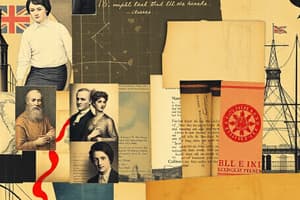Podcast
Questions and Answers
What cultural group inhabited much of what is now England during the Early Middle Ages?
What cultural group inhabited much of what is now England during the Early Middle Ages?
Anglo-Saxons
When did the Germanic settlers arrive in Britain?
When did the Germanic settlers arrive in Britain?
5th century
When did the term 'Anglo-Saxon' emerge?
When did the term 'Anglo-Saxon' emerge?
8th century
What is the approximate percentage of Old English vocabulary retained in the modern English language?
What is the approximate percentage of Old English vocabulary retained in the modern English language?
What was the fundamental unit of production throughout the Anglo-Saxon period?
What was the fundamental unit of production throughout the Anglo-Saxon period?
Who was sent by Pope Gregory the Great to convert the Anglo-Saxons to Christianity?
Who was sent by Pope Gregory the Great to convert the Anglo-Saxons to Christianity?
Which notable figure oversaw improvements in law and education during the Anglo-Saxon period?
Which notable figure oversaw improvements in law and education during the Anglo-Saxon period?
What were the cultural emblems of the Anglo-Saxon period that can still be seen today?
What were the cultural emblems of the Anglo-Saxon period that can still be seen today?
What impact did the Anglo-Saxon period have on England's identity and institutions?
What impact did the Anglo-Saxon period have on England's identity and institutions?
What marked the end of Viking attempts at conquering England?
What marked the end of Viking attempts at conquering England?
Flashcards are hidden until you start studying
Study Notes
Anglo-Saxon Period
The Anglo-Saxons were a cultural group that inhabited much of what is now England during the Early Middle Ages, speaking Old English. Their roots trace back to Germanic settlers who arrived in Britain from mainland Europe in the 5th century. The term "Anglo-Saxon" emerged in the 8th century, referencing the Germanic language spoken by the inhabitants of the region.
Origin and Cultural Identity
The Anglo-Saxons' cultural identity developed from the interaction of the Germanic settlers with the pre-existing Romano-British culture. Their language and political structures are the direct predecessors of the medieval Kingdom of England and the Middle English language. Despite significant changes due to Danish and Norman invasions, the modern English language retains approximately 26% of its vocabulary from Old English, primarily consisting of everyday speech.
Timeframe
Historically, the Anglo-Saxon period encompasses the time between roughly 450 and 1066, corresponding to the period following their initial settlement until the Norman Conquest. During this time, the Anglo-Saxon identity evolved, particularly through the adoption of Christianity. The diverse narratives of the people emphasized local and extended kin groups, which remained the fundamental unit of production throughout the Anglo-Saxon period.
Material Culture
Anglo-Saxon material culture can still be seen today in various forms, such as architecture, dress styles, illuminated texts, metalwork, and other art. These cultural emblems reflect strong tribal and lordship ties. Elite individuals declared themselves kings and developed burhs (fortifications and fortified settlements), identifying their roles and peoples in Biblical terms.
Religious Transition
Initially, the Britons followed the Roman form of Christianity. However, after the withdrawal of Roman authority, the Anglo-Saxons remained pagan. In 597, St. Augustine was sent by Pope Gregory the Great to convert the Anglo-Saxons. Slowly, the seven kingdoms adopted Christianity, becoming exemplary Christians themselves. Some Anglo-Saxon kings even reclaimed their old tribal homelands in Germany, where they had once resided as pagans, as Christians.
Key Figures
Notable figures during the Anglo-Saxon period included King Alfred the Great, who fashioned himself as 'King of the Anglo-Saxons' and oversaw improvements in law and education. His reign also marked the end of Viking attempts at conquering England.
Impact of the Anglo-Saxon Period
The Anglo-Saxon period played a crucial role in shaping England's identity and institutions. The country experienced considerable political, economic, and cultural developments that influenced the formation of the modern state.
Studying That Suits You
Use AI to generate personalized quizzes and flashcards to suit your learning preferences.




